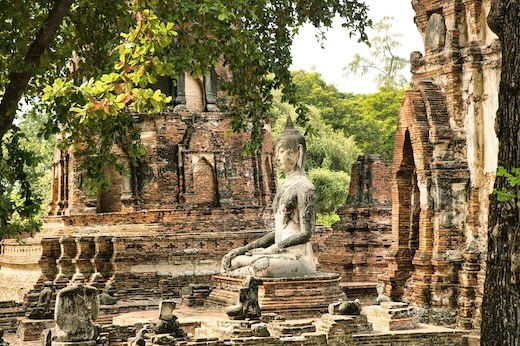Day 1: Angkor Wat
Morning: Start your adventure with a sunrise visit to Angkor Wat, Cambodia’s crown jewel and the largest religious monument in the world. Arrive around 5 AM to catch the temple silhouette reflected in the lotus pond—a truly iconic scene. After sunrise, step inside the central sanctuary, admire the bas-reliefs depicting Hindu epics, and climb the upper levels for panoramic views.
Next, head over to Angkor Thom, the ancient royal city built by King Jayavarman VII. Enter through the South Gate, flanked by stone gods and demons, and proceed to the awe-inspiring Bayon Temple. Its many stone towers, each carved with serene, smiling faces, create a mesmerizing atmosphere. Continue your exploration at Baphuon, Phimeanakas, and the Elephant Terrace.
Afternoon: After a lunch break, make your way to Ta Prohm, the temple famously wrapped in the roots of towering silk-cotton trees. This atmospheric site is less restored, allowing nature to reclaim its space and giving you that unforgettable “Tomb Raider” feel.
Wrap up your afternoon at Preah Khan, another sprawling temple with crumbling walls and intertwined tree roots. It’s often quieter than the other major sites, offering a peaceful close to your temple circuit.
Evening: Head back to town and relax with a stroll along Pub Street, Siem Reap’s vibrant nightlife hub. Even if you’re not into partying, the street performers, markets, and buzzing energy make for great people-watching.

Save Tip:
Purchase a 3-day Angkor Pass instead of a single-day ticket. It costs more upfront, but gives you flexibility and is much cheaper per day.

Splurge Tip:
Hire a certified guide and private tuk-tuk driver for the day. You’ll get historical context, optimized routing, and much-needed comfort.
Day 2: Greater Angkor and Local Life
Morning: Venture out on the Angkor Outer Circuit, starting with Banteay Srei, often called the “Jewel of Khmer Art.” Though smaller than Angkor Wat, this temple’s intricate pink sandstone carvings are unmatched in detail. Get there early to beat the group tours and appreciate its delicate beauty.
En route back, stop by Banteay Samré, a lesser-known temple that’s peaceful and architecturally harmonious. Then swing by Ta Som, with its tree-swallowed entrance, and Neak Pean, a small island temple in the middle of a reservoir.
Afternoon: Have lunch near Srah Srang, the royal bathing pool, then spend your afternoon visiting Kampong Phluk, one of Siem Reap’s famous floating villages on Tonlé Sap Lake. Travel by boat through the stilted houses and flooded forest. Depending on the season, you might witness local fishermen at work or children paddling home from school.
Evening: Back in Siem Reap, head to the Made in Cambodia Market. Browse stalls of locally made products—artisan crafts, natural cosmetics, and handmade jewelry. Unlike typical souvenir spots, vendors here often represent social enterprises and independent creators.

Save Tip:
Skip group tours and arrange a tuk-tuk to the outer temples—most drivers offer fair rates and wait for you at each stop.

Splurge Tip:
Take a private sunset boat cruise on Tonlé Sap with wine and canapés. It’s a serene, photogenic way to end your day.
Day 3: Siem Reap Town, Art and Culture
Morning: Start your day at the elegant Angkor National Museum. Its galleries offer fantastic background on Angkor’s art, history, and religious symbolism—ideal for piecing together what you’ve seen so far.
Then take a short tuk-tuk ride to Wat Bo, one of the city’s oldest pagodas. Unlike the busy Wat Preah Prom Rath, Wat Bo is peaceful and features unique murals blending Khmer and European artistic styles. Nearby, stroll along the Siem Reap River Walk, a shady, slow-paced trail lined with small shrines and bridges.
Afternoon: Head to the Artisans Angkor workshop, where you can watch apprentices learning traditional stone carving, woodwork, and silk painting. This social enterprise supports rural youth and offers beautiful products made on-site. From here, visit Theam’s Gallery, a combination of art studio, home, and museum created by Cambodian artist Lim Muy Theam. The peaceful garden setting is as memorable as the contemporary Khmer art on display.
Then spend time exploring the Old Market (Psar Chas). From spices to silver to handmade bags, it’s a chaotic but colorful spot to pick up souvenirs and practice your bargaining skills.
Evening: Close your Siem Reap adventure with a cultural performance. The most famous is the Phare, The Cambodian Circus, where acrobatics, theater, and music come together to tell uniquely Khmer stories. It’s inspiring, energetic, and a great cause—many performers are former street kids trained through the Phare Ponleu Selpak arts school.

Save Tip:
Visit the Artisans Angkor main site for a free guided tour of their workshops and demonstration areas.

Splurge Tip:
Book VIP seats at Phare Circus, which include a welcome drink, front-row views, and the chance to meet performers after the show.

Siem Reap is really budget-friendly, so take advantage by booking a boutique hotel with a pool and daily breakfast included—often for less than what you’d pay for a hostel bed in major cities. Try luxurious full-body massages that cost just a fraction of Western prices, making self-care part of the adventure!

